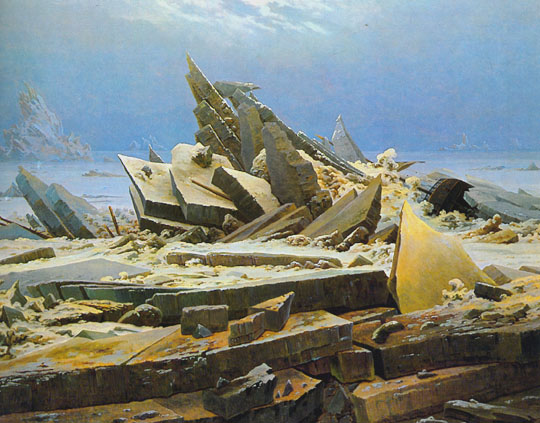
The North-West Passage. 1874. Sir John Everett Millais Bt PRA (1829-96). Oil on canvas, 1765 x 2222 mm. Courtesy of the Tate, NO1509. Presented by Sir Henry Tate 1894. Image released on the Creative Commons CC-BY-NC-ND (3.0 Unported) License. Click on image to enlarge it.
Commentary by text by George P. Landow
Millais’s painting beautifully combines a range of popular nineteenth-century pictorial motifs and situations. To begin with, like George Elgar Hick’s Woman’s Mission: Comfort of Old Age, it depicts a younger woman, most likely a daughter in both works, comforting a man near the close of life, so it presents an idealized view of both gender roles and the stages of human life. Furthermore, it also contrasts the Victorian ideal of domesticity, of the home as a protected, safe place, to the challenges of the exterior world, and in so doing it hints at the opposition that Lorenz Eitner pointed to as characterizing Romanticism in his classic “The Open Window and the Storm-tossed Boat,” though here, of course, the vessels are all in memory and imagination. Millais uses multiple pictorial details to make these oppositions clear: on the table at the old sailors right sits a glass of grog, rum or brandy and water, with a lemon nearby, and above his head we have a portrait of Lord Nelson, the naval hero who first lost an arm and then his life in defense of Britain, while on the table behind the young woman we see contrasting objects — a map of Northern Canada and the Arctic and fresh, fragile flowers, which echo both the young woman’s beauty and youth. Finally, on the floor at next to the old man’s chair we see a book containing the old seaman’s plans and records of past voyages.

Sea of Ice (or Arctic Shipwreck) by Caspar David Friedrich. 1823-4, Kunsthalle, Hamburg. Click on image to enlarge it.
As the Tate Britain website explains, “The north-west passage was the unnavigable sea route round North America which was thought to provide a passage to the East. In time, it became synonymous with failure, adversity and death, with men and ships battling against hopeless odds in a frozen wilderness. Previous representations had shown the desolate beauty of the terrain with details such as wrecked ships to underline the futility of man’s ambition.” Friedrich's Arctic Shipwreck exemplifies this theme in nineteenth-century painting: only the stern of the vessel remains visible among the crushing heaves of jagged ice which mark the desolation of an arctic wasteland. According to the Tate, Millais painted this picture in 1874 “when another English expedition was setting off.”
Bibliography
The Pre-Raphaelites. Ed. Leslie Parris. Exhibition catalogue. London: Tate Gallery, 1984, reprinted 1994.
Eitner, Lorenz. “The Open Window and the Storm-tossed Boat: an Essay in the iconography of Romanticism.” Art Bulletin. 37 (1959): 281-90.
Millais, J.G. The Life and Letters of Sir John Everett Millais. 2 vols. London: 1899.
Last modified 8 July 2018